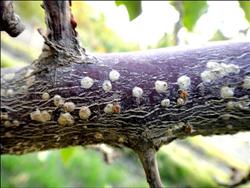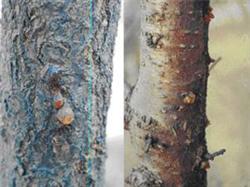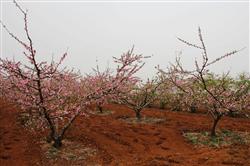How to control apricot scale insects?

How to control apricot scale insects? When does apricot scale beetle occur? Is there any way to control apricot trees? please introduce that the area of apricot trees is expanding year by year, followed by the expansion of the harmful species of apricot scale insects, and the damage is becoming more and more serious. at present, scale insects have become one of the main factors affecting the production of apricot trees in our county. 1. Occurrence species, mulberry scale: nymphs and adults are fixed on the branches to suck apricot sap. In severe cases, the branches are all covered by worms, as if covered by a layer of gray-white wax. 2. Apricot ball scale: the insect sucks the sap of plant branches with female adults and nymphs, and serious female excretion of honeydew can induce coal disease and trap Sautéed Vermicelli with Spicy Minced Pork, thus weakening the tree potential and affecting photosynthesis. 3. Korean bulbous scale: female adults and nymphs are used to suck the sap of branches, leaves and fruits, and the female can also excrete honeydew and affect the growth of trees. 4. Japanese tortoise wax scale: adult scale and nymph are parasitic on plant branches. On the leaves, the tissue juice is absorbed by piercing and sucking mouthparts, which can cause pollution disease seriously. The above scale insects can delay the germination and affect the flowering of apricot trees. The buds and buds of the damaged parts are shriveled, unable to sprout and blossom, or some flowers do not bloom, and serious branches or whole branches die due to the obstruction of nutrient supply. Second, the occurrence regularity of mulberry white scale occurs two generations a year, with fertilized female adults overwintering on the branches, and damage after the sap begins to flow in the following year. The eggs began in late April, the nymphs began to hatch in early May, and the first generation nymph flourished in late May. The egg peak of the second generation was in the middle and late ten days of June, the nymph initial stage at the end of July and the nymph peak in the first ten days of August, which were mostly fixed at the base of one-year-old branches. after mating in late August, the male died and the female continued to endanger, and the overwintering began at the end of September with the decrease of temperature. Apricot ball scale occurs one generation a year, overwintering with 2-year-old nymphs in 1-2-year-old branches. After the sap began to flow in the following year, the nymphs were mostly fixed in the warped bark and branches along the branches in the middle of March, and the female began to expand, entering the egg stage in late April, the nymph hatching period in the middle of May, the nymph peak in late May, and the nymphs secreting white wax powder in the summer from mid-late July to mid-August. the temperature decreased in late August and the nymphs peeled and shelled until November, and the back was fixed with wax. The Korean bulbous scale occurs once a year, with the 2nd instar nymph overwintering on 1-2-year-old branches, the overwintering position of the same branch with the apricot scale moves down, the sap flow begins to sting in spring, and the female begins to expand in the middle of March. the peak period of expansion is in the middle of April, the male adults are seen in the middle of April, and the damage is the most serious from the first ten days of April to the beginning of May of the year. It is harmful for nymphs to climb to the front or back of the leaves along the branches, and a few move to the concave fruit. After being fixed, the nymph secreted extremely thin wax cover, peeled off and became 2 years old from the end of September to October, and then moved back to the branches to survive the winter at the end of October or early November. The Japanese tortoise wax scale occurs once a year, which overwinters mainly as fertilized but immature female adults on one-year-old branches, and most of those with the same branches as ball scale overwintering on two-year-old branches. The female adult began to lay eggs in the middle of May, the egg peak period was about 20 days in early June, and the hatching period was about 20 days in late June. the hatching nymph moved to the leaf to fix the back of the body with a white wax shell, which was fixed to the middle of August to the middle of September. After female and male mating, the male adult died, the female adult gradually returned to branches, and the middle of September was the peak stage of backbranching, which was always fixed as a pest after the return of branches, and overwintered with the decrease of air temperature. The newly hatched nymphs of shell insects can be transmitted over a long distance by wind. Third, prevention and control. In order to control scale insects, the best control period must be selected and integrated control should be adopted. The main results are as follows: 1. Artificial control, combined with pruning to cut off the seriously damaged insect branches, hard brush or steel brush is used in winter and spring to remove and pinch the insect bodies on the branches. 2. Biological control. The main purpose is to protect natural enemies. During the female expansion period of scale insects and the peak hatching period of nymphs, biological pesticides should be selected, with or without broad-spectrum pesticides as far as possible, so as to reduce the killing of natural enemies such as ladybugs, parasitoids and lacewings, and make full use of the control ability of natural enemies. 3. Chemical control. During the period of tree germination in spring, spray with 5-Bomedo stone-sulfur mixture (temperature above 10 ℃) or 40-speed culling 500-700 times solution to control many kinds of scale insects. During the nymph occurrence period, 25% cypermethrin and other pyrethroid pesticides must be added before the newly hatched nymphs are waxed. 4. Application of medicine in shade. Combined with irrigation in spring, the trunk was smeared with high-efficiency and low-toxic organophosphorus pesticides, after fruit harvest or before returning branches of Japanese tortoise wax scale and bulbous scale, such as 1:2 or 1:3 omethoate. It can not only control a variety of scale insects but also protect natural enemies. Matters needing attention 1. Stone-sulfur mixture is sensitive to some varieties and is easy to delay maturity after use. Spray seriously with a spray gun, otherwise it will cause drug damage. 2. Diflubenzuron 3 and dimethoate are late-acting agents, which must be used before the nymphs hatch wax. 3. Methamidophos is an organophosphorus pesticide, which can only be sprayed after harvest or in spring, and is prohibited during fruit growth. 4. Stop using beta-cypermethrin 15 days before harvest and should not be used continuously for many times to avoid resistance. 5. Spraying must be meticulous and careful, so that the tree body can be sprayed comprehensively and evenly. Click to get more apricot planting techniques click to get more fruit planting techniques
- Prev

How to prevent and cure apricot gum disease?
How to prevent and cure apricot gum disease? What is the cause of apricot gum disease? Is there any way to prevent and cure apricot gumming disease is a non-infectious disease, trunk and fruit can be affected. Soft gelatinous material flows from the bark of the branch or the crack of the wound when the disease occurs, and it becomes hard when it comes into contact with air.
- Next

What is the use of spraying water during apricot flowering?
What is the use of spraying water during apricot flowering? How should I spray water? Please introduce that the flowering period of apricot is in the dry and windy season, and the apricot flower stigma dries quickly, which affects the development of pollen and reduces the fruit setting rate. The practice shows that spraying clear water at the flowering stage of apricot can significantly increase the fruit setting rate, which is more than 4 times higher than that without water spraying.
Related
- Moge, come on! The staff of the peasant association in the producing area of cantaloupe were frightened when the crowd gathered.
- Causes and Solutions of low Fruit setting rate of Apple
- Symptoms and control measures of passion fruit virus disease
- Fruit growing lesson: how do apple orchards keep high yields?
- Can you build orchards in the mountains? What are the pros and cons?
- How to manage the coloring period of Crisson grape?
- This paper introduces the processing technology of two kinds of fig products.
- How much is a month for retired teachers in rural areas by 2020?
- How can strawberry planting increase sugar content? We should pay attention to management in many aspects.
- What are the cultivation techniques on how to improve the yield of golden fruit?

